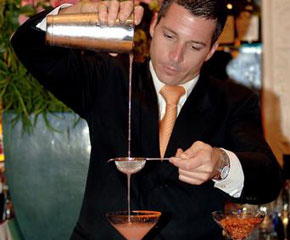The head bartender at New York City’s Daniel restaurant, Xavier Herit, is one of many mixologists who are reinventing drinks by infusing non-traditional flavours into alcohol, or altering the physical properties of drinks to form gels, foams and mists.
Molecular mixology is a movement inspired by molecular gastronomy, a science-meets-cooking trend popularised by chefs including Ferran Adria of El Bulli restaurant in Spain and Heston Blumenthal of the Fat Duck restaurant in the English town of Bray.
Molecular mixology blurs the line between food, drink and chemistry.
“The bar is like a theatre,” Herit says, standing in front of customers with a syringe filled with strawberry-infused Cointreau and sodium alginate and is part of his arsenal of tools.
After delicately pushing drops of his strawberry-liqueur mix from the syringe into a calcium bath, minutes later they emerge as tiny pink caviar-like beads.
At Tailor, another New York restaurant, bartender Eben Freeman tosses rice crispies in Kahlua, dehydrates them and repeats the process. He adds them to a vodka milk mix for a White Russian breakfast cereal.
The drinks are not cheap and can cost up to $29. But the hours of experimentation, meticulous preparation and elaborate presentation offer curious cocktail lovers and gastronomes a completely new experience.
One of his earliest molecular incarnations was a gelatinised gin and tonic on a lime chip.
For mixologists like Freeman and Herit, their imaginations run wild with molecular mixology possibilities.
Freeman is working on a spicy greyhound push-pop, consisting of gin, grapefruit juice and chilli pepper, as well as absinthe gummy bears and Negroni caviar.
Herit plans to fast-freeze cocktails in front of customers.

